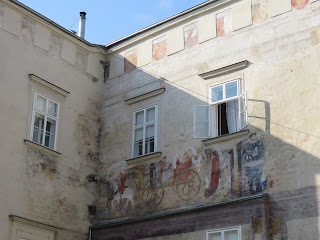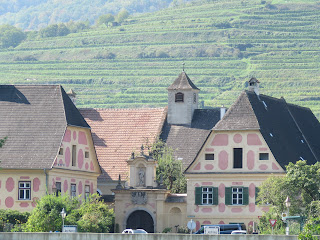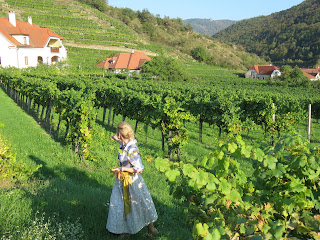The Austrian Salzkammergut, or, translated, the property of
the salt chamber, is the vacation spot for all Austrians. Much of central
Europe was, millions of years ago, the floor of a great sea, as we may have
mentioned in a previous post when we went to the salt mine in Krakow. With the
combination of plate tectonics pushing the land up and creating the mountains,
and water evaporation, the whole area became literally a salt chamber. When
settlements came and people realized the value of salt for things like food
preservation, it became a very important commodity and the basis of the economy
of the region. The city of Salzburg was a major hub for this economy. As most
of us learned years ago, the Romans paid their soldiers in salt because it was
measured against gold - this was called 'salarium', and is now the basis of the
word 'salary' that we use in English.
The changes in the landmass also created these lakes, of
which there are seven or eight of significant size. Our full day excursion took
us to see three of them - Attersee, Wolfgangsee and Mondsee. The Salzkzmmergut
lakes are all fed by mountain streams and rivers, making the water quite
beautiful against the backdrop of the trees and high hills.
Our first stop was the Attersee, where we took a boat ride
from the south of the lake at the town of Attersee to the north end, at
Unterach. We had a gorgeous day for it, although the morning mist on the water
made the opposite side of the lake a little haze-covered.
Our next stop was in the town of St. Wolfgang on the
Wolfgangsee. This has been a tourist town for hundreds of years, and it is easy
to see why. What a beautiful place, with narrow alleyways and houses with
colourful flower boxes under the windows.
 |
| A shop selling local Lebkuchen, or gingerbread. Had to buy some! |
One of the most famous places in town is actually the
Romantik Hotel 'Im Weissen Rössl', or the White Horse Inn. It has
been a proper inn for 130 years, owned by the same family since 1912. It has
such a history in the lake district that an operetta 'The White Horse Inn',
with the hotel as the backdrop, was written in the 1930s and turned into a
movie musical in the 1950s.
Monica's parents had stayed there as well. We have photos of
them with their friends Hanna and Karl, sitting out on the patio beside the
lake, with light snow covering everything. This would have been in October in
the early 1990s. We'll see if we can find one or two and add them to the post
when we get home. Here are some views over the lake from the courtyard between the church and the inn.
The Pilgrimage Church of St. Wolfgang was probably the main reason people started coming to this town. The story in 976 of Bishop Wolfgang of Regensburg says he was living a hermit's life in the area and decided to build a church here. He threw his axe, vowing that wherever it landed he would build his church. He found the axe on a rocky hill beside the lake and, as promised, built it. There has been a church here ever since, and there has been a place for pilgrims to rest their heads nearby for almost as long. The White Horse Inn itself may not have a really long history, but its site has been used for more than 1000 years.
After an orientation we had some free time to wander around
St. Wolfgang before setting off for a light lunch at a local inn. Of course,
the guys in our group - we had found our nearest 'neighbour' on the tour, Nancy
from Buffalo, traveling with her brother Bob, along with another Bob and Tom,
and hung around together when we were on the same tours - found a local
bierstube with a lovely patio by the lake. Bob #1 is a beer drinker and has to
try local beer, or at least certain brands, wherever he goes. Nancy tried the
Palatschinken, dessert crepes filled with apricot preserves, and loved them!
 |
| Larry and Bob #1 |
 |
| Nancy and her Palatschinken |
We were all sorry to leave St. Wolfgang for the lunch; there
were so many great places in town that we suggested to the tour directors that
we should actually have lunch on our own here - they said 'write it in your
comments; head office reads every one!'. But the lunch stop was still quite
nice. Lunch was served from a big platter - smoked ham and cooked ham, cheeses,
mixed cold cuts and a couple of cheese spreads along with rye breads. And for
those who wished, tasting of locally made schnapps, hosted by the distiller.
One flavoured with dark chocolate and chili pepper was so good that we bought a
bottle to bring home - it will be delicious over ice cream (Barb and Jane)!
Our final lake district view was the Mondsee. We didn't stop
here, but drove along one shoreline to get to the Autobahn that would take us
back to Linz. Mondsee has two claims to fame: #1 - it is actually privately
owned - yes, the whole lake! The lady who owns it now wanted to sell it for 45
million Euros, but the Austrian government only wanted to pay her 3 million
Euros, so there's been no deal yet. Mind you, if you happen to have the change
in your pocket, be aware that almost all of the shoreline is already owned by
cottagers and towns, so you'd be paying all this money for 'a lot of water and
fish', as our tour guide put it! Claim to fame #2 - the Sound of Music (yes,
we're back to that!) cathedral wedding scene was filmed in the St. Michael's
church in the town of Mondsee.
 |
| The spires in the distance are on St. Michael's Church in the town of Mondsee. Tiny town, huge church - seems to be the done thing around here! |
All in all a picture-perfect day, as you can see from the
pictures! We left Linz for Passau and our last sailing opportunity after
dinner. We were up top again for a while to enjoy what we could.












































































